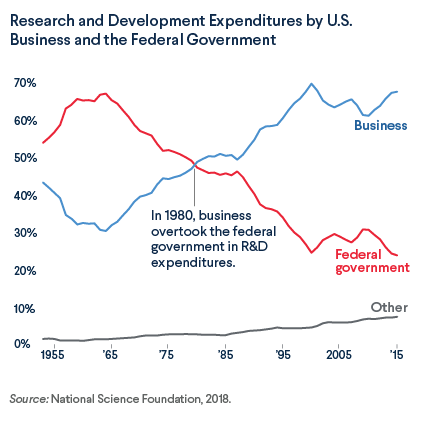METARESEARCH AND DEVELOPMENT
Changes in R & D funding and allocation
In a new report on workforce training and technological competitiveness, a task force led by former Commerce Secretary Penny Pritzker describes recent trends in research and development investment. Despite the fact that “total U.S. R&D funding reached an all-time high of nearly $500 billion in 2015, nearly three percent of U.S. gross domestic product,” the balance in funding has shifted dramatically to the private sector: “federal funding for R&D, which goes overwhelmingly to basic scientific research, has declined steadily and is now at the lowest level since the early 1950s.” One section of the report contains this striking chart:

Link to the full report. ht Will
- A deeper dive into the report’s sourcing leads to a fascinating repository of data from the American Association for the Advancement of Science on the U.S. government’s investments in research since the 1950s. Alongside the shift from majority federal to majority private R&D funding, the proportion of investments across different academic disciplines has also changed significantly. One table shows that the share of federal R&D funding for environmental science, engineering, and math/computer science has grown the most, from a combined 43.2% in 1970 to 54.8% in 2017. Meanwhile, funding for social science research has decreased the most. In 1970, the social sciences received 4.3% of the government’s R&D funding; but in 2017, that share had fallen to 1.8%. Much more data on public sector R&D investments is available from the AAAS here.
- A March 2017 article in Science explains some of these shifts.
- A section of a 1995 report commissioned by the U.S. Senate Committee on Appropriations charts and contextualizes the explosion of federal research and development funding in the immediate aftermath of the Second World War.
- A study from the Brookings Institution finds that federal funding for research and development accounts for up to 2.8 percent of GDP in some of the largest metropolitan areas in America. The authors have fifty ideas for how municipalities can capture more of the economic impact generated by that R&D.
- Michael comments: “With the diminishing share (4.3% to 1.8% of total government research) of halved expenditures—and business not naturally inclined to conduct this kind of research (except in, as one would expect, instances of direct business application like surge pricing and Uber)—social science research appears to no longer have a natural home.”
FUNCTIONAL FORMS
Current and future effects of machine learning on economics
SUSAN ATHEY goes into depth on some of the ways in which machine learning is already used in economics, then offers predictions, including an “increase in interdisciplinary research.” The paper contains much of interest, such as discussion of new techniques for causal inference:
“The emerging literature in econometrics and statistics combining machine learning and causal inference… is providing insights and theoretical results that are novel from the perspective of both ML and statistics/econometrics.
…
‘Outsourcing’ model selection to [an] algorithm works very well when the problem is ‘simple’–for example, prediction and classification tasks, where performance of a model can be evaluated by looking at goodness of fit in a held-out test set. Those are typically not the problems of greatest interest for empirical researchers in economics, who instead are concerned with causal inference, where there is typically not an unbiased estimate of the ground truth available for comparison. Thus, more work is required to apply an algorithmic approach to economic problems. The recent literature at the intersection of ML and causal inference, reviewed in this paper, has focused on providing the conceptual framework and specific proposals for algorithms that are tailored for causal inference.”
Full paper here.
- Real-world example: for a recent paper on monopsony, Arindrajit Dube tested out the “double ML” method for causal inference and found it performed “quite well”: “It’s one case, but our findings that estimates from a leading machine-learning based causal inference procedure (“double ML”) compare favorably to those from randomized evaluations are broadly supportive of the core arguments made by Susan Athey.”
PLURALISTIC VIEW OF EQUALITY
On Tim Scanlon’s new book, Why Does Inequality Matter?
In the Boston Review, Martin O’Neill offers context on Scanlon, “one of the most powerful and insightful moral and political philosophers of recent decades.” In regard to the book, O’Neill writes: “Scanlon’s account of equality isn’t simple; it resists capture in a one-line slogan. It is, one might say, frustratingly complicated.” Link to the article.
In his conclusion, Scanlon points out that inequality comes in many forms:
“One strength of the pluralistic view of equality that I am offering is that it recognizes the differences between different forms of inequality. In addition to the inequality between the very rich and the rest of us, there is the inequality between the comfortably well off and the very poor, racial inequality, and the various forms of inequality between men and women. These are all troubling, but they are objectionable for different reasons, not simply because they are all violations of a single requirement that the prospects of individuals should be equal (in the absence of some special justification.)
“Racial inequality involves objectionable inequality in status, lack of economic opportunity, unequal provision of education and other important public services, and unequal treatment by the legal system. It also involves a denial of access to effective means of political influence, including in many cases denial of the right to vote. Similarly, gender inequality also involves objectionable inequality in status, and lack of equal economic opportunity, because of discrimination in hiring and in access to education. It also involves, and has been perpetuated by, discrimination that has prevented women from attaining positions of political influence.
“Inequality between the very poor and those who are better off involves the lack of economic opportunity, due to lack of access to education, and inadequate provision of other important public services, such as health care. The poor also suffer from a lack of control over important parts of their lives. They are subject to control by others in their working lives, have little choice of occupation, and suffer from what Jiwei Ci calls agency poverty as well as status poverty. Their interests are also inadequately represented in the political system.”
Scanlon emphasizes that these different forms of inequality can be objected to on different bases. “Unequal Outcomes” (the penultimate chapter) and the conclusion are available in draft form here.
- In his introduction, Scanlon mentions his 1996 lecture “The Diversity of Objections to Inequality,” accessible here: “My hypothesis is that the bare idea of equal consideration leads us to substantively egalitarian consequences only via other more specific values that I will enumerate, most of which are not essentially egalitarian.”
- Another work that formed the basis of the book is “When Does Equality Matter,” found here.
+ + +
- “We take the roads built during the Roman Empire as our point of departure.” A study on the provision of public goods and development persistence maps the road network of the Roman Empire alongside contemporary light intensity at night, finding a link “between the location of ancient roads and economic activity today.” Link.
- “Living in a more segregated county substantially reduced the impact of GI Bill benefits on white homeownership rates, suggesting that segregated locations potentially hindered both white and black homeownership.” Link.
- Matthew Desmond’s new project, The Eviction Lab, is the first countrywide database of evictions, going back to 2000. From Desmond’s intro: “This is just the beginning, and we need your help… Use the data. Researchers and journalists can take this information and deepen what we know about the prevalence, causes, and consequences of residential insecurity. Citizen organizers and elected officials can examine trends in their communities to design effective policy solutions.” Link to the site, and link to coverage of its launch in the Times.
- “In general, small cities will have higher portions of their workforce replaced by machines than large cities. The reason: While cities of all sizes have many easily automated jobs (like card dealers, fisherman, cashiers, and accountants), large cities like Boston also have larger shares of managerial and knowledge professions (like lawyers, scientists, and software developers).” Link. ht Jay
- Huang’s Law: “However, despite the imminent passing of Moore’s law, we are beginning to see a new and interesting class of phenomena. For a certain class of programs, namely deep networks, code does seem to grow faster almost by magic.” Link. Jack Clark offers commentary. ht Margarita
- A new study on child labor and wages from the 1200s to 1800s. Link.
- “Medical expenses account for roughly 4 percent of bankruptcy filings among nonelderly adults in the U.S.… The 4 percent figure is lower than some commonly cited estimates, but the new statistic comes with a twist: It is part of a larger research project that found multiple negative economic consequences of having medical problems, including a 20 percent drop in earnings and an 11 percent drop in employment for adults between ages 50 and 50 who had been hospitalized.” Link. ht Jack B.
- A brief monetary history of Ireland and the Famine, from the excellent Economic History Society blog The Long Run. Link.
- Matt Bruenig enters the Job Guarantee discussion again with a critical post at 3P: “One way to go about the hypothetical exercise is to compare the job guarantee idea to a more conventional alternative: unemployment benefits.… The question for a job guarantee is what exactly it delivers that the infinite basic unemployment benefit scheme does not?” Link. (And link to his previous.)
- Ozan Jaquette, whose work we previously spotlighted, writes in the New York Times: “Our data suggests universities are determined to court wealthier students over others, and they expend substantial resources identifying and reaching them.” Link.
Filed Under
Each week we highlight research from a graduate student, postdoc, or early-career professor. Send us recommendations: editorial@jainfamilyinstitute.org
